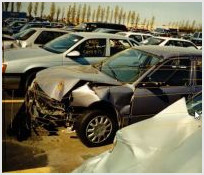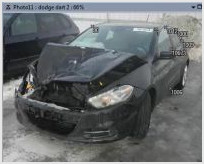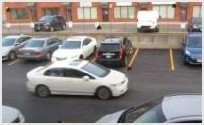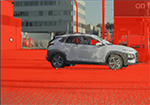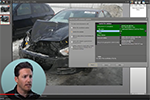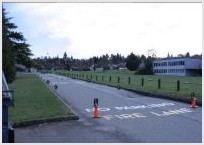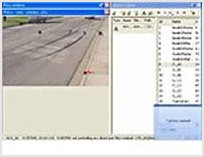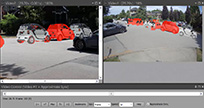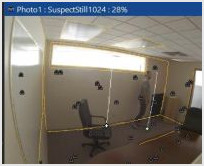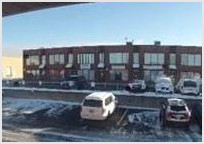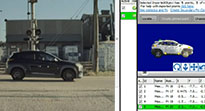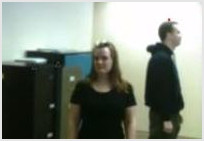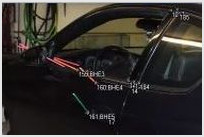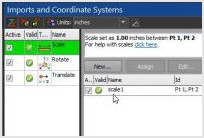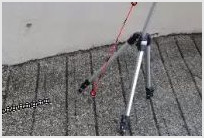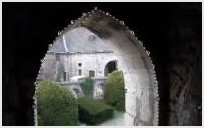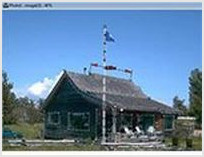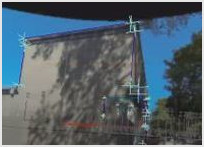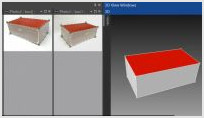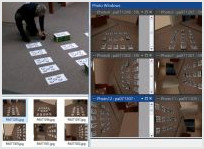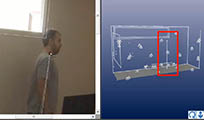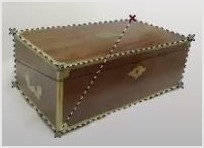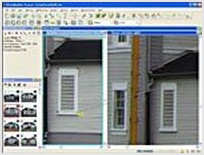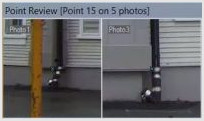Forensics Tutorials and Videos
Various techniques in public safety, accident reconstruction and forensics.
Accident Reconstruction
Dealing specifically with vehicles and crashes.
| Car Crush |
|---|
Measure the crush of a vehicle from photos taken by an unknown camera, using an exemplar vehicle.
|
|
| Crush from an Exemplar |
|---|
Measuring the crush of a vehicle from photos of an unknown source by adding them to a solved project of an exemplar and freezing the points.
|
|
| Image Sequences |
|---|
How to use image sequences to track the location of a vehicle over time.
|
|
Back to top
| Using 3D Import Surface Pinning and LIDAR Data to Solve Vehicle Speed |
|---|
The Surface Draw based import pinning mode is used to pull in a LIDAR scan of a vehicle to pin to a photo and a surface from a scene scan. And vehicle speed is estimated.
|
|
| Using Video from a Fixed Location |
|---|
How to import and use video that is from a camera in a fixed location for forensic work and speed analysis.
|
|
| Using a Laser Scanned Exemplar to Model Crush |
|---|
3rd-party video. This video, created by Lou Peck of Lightpoint Data, demonstrates how to use a vehicle laser scan to model accident crush from photos.
|
|
Back to top
| Road Diagram |
|---|
Creating a diagram of a road scene using multiple photos and a calibrated camera.
|
|
| Road Single Unknown Photo |
|---|
Creating a diagram of a skid mark on road surface from a single camera of unknown origin with control points.
|
|
| Crush Analysis |
|---|
3rd party video. This video by David Yarr of Top View Animation shows a photo-based method for estimating vehicle crush.
|
|
Back to top
| Importing Multiple Video Files |
|---|
Describes how multiple video files can be used in one PhotoModeler Premium project for accident reconstruction speed analysis.
|
|
| |
Back to top
Single photo security camera
Examples of projects and features useful for forensic cases
| Single Photo Security Camera |
|---|
Getting measurements from a single security camera with high lens distortion. Describes steps-by-step, and how to quality checks.
|
|
| Use LIDAR to Help Solve a Single Photo Forensics Case |
|---|
The video describes how PhotoModeler can use a 3D laser scan (LIDAR) of a crime scene to solve and extract information from a security / surveillance camera.
|
|
| Ray Pinning |
|---|
Shows how to manually place, or pin to rays/2D points, a point cloud in a single photo project.
|
|
Back to top
| Determining a suspect's height from an unknown surveillance camera |
|---|
Using PhotoModeler, a suspect's height can be measured from a single photo from an unknown camera. This technique shows the use of control point data to solve the camera position. This video shows one of the techniques described in the KB article "Using offset points for forensic height".
|
|
| Establishing Vehicle Speed from Surveillance Video |
|---|
3rd-party video. This video, created by Ben Molnar of Lightpoint Data, demonstrates how to use a laser scan of a scene to extract data (such as vehicle speed) from video surveillance footage. Note that the video frame extraction can be done by PhotoModeler or VLC as well.
|
|
|
Back to top
Features
Useful and interesting features of PhotoModeler that are used in Forensics projects.
| Import Pinning Examples |
|---|
Shows a few examples in forensics and in boat canvas where pinning of imported objects can be used.
|
|
| Measure |
|---|
Demonstrates how to use the Measure pane. Display various types of measurements of objects and between objects.
|
|
| Extending cylinders, lines or edges and measuring their intersection point |
|---|
PhotoModelers cylinders, lines and edges all have a property that allows the 3D view to extend their length allowing for visualization of intersections. Additionally, selecting multiple objects calculates their closest intersection point.
|
|
Back to top
| Scale / Rotate / Translate |
|---|
Use of the 'Imports and Coordinate Systems' tool to set up Scales, Rotations, and Translations.
|
|
| Leveling a project to gravity |
|---|
Using a plumb line PhotoModeler projects can be leveled to gravity to perform slope and Z offset calculations.
|
|
| Using Image Enhance |
|---|
The Image Enhance pane can be used to bring out details that are hard to see. Adjust the image contrast, brightness or gamma to improve visibility of key details and help improve marking.
|
|
Back to top
| Dimensions |
|---|
How to create annotation text and dimension lines on photographs.
|
|
| Aligning photos in 3ds Max |
|---|
Accurate camera alignment can be achieved in 3D Studio Max using photogrammetry. PhotoModeler outputs full camera positions and matching image planes. The optional idealize stage remaps the images to account for lens distortion, improving the alignment.
|
|
| Point Selection in Clouds |
|---|
Describes the two ways you can select the points within a Point Cloud, and some examples of how to use these points.
|
|
Back to top
Background
Basic introductory topics useful for those working on Forensics projects.
| User Interface Overview |
|---|
Covers PhotoModeler's interface, Ribbon, status bar, and Windows pane interface, and customization.
|
|
| Manual Points Project |
|---|
For manual marked projects (or when you need to add manual marks and references to an automated project). Covers completing a simple manual points-based project start to finish.
|
|
| Calibration Multi-sheet |
|---|
How to pre-calibrate a camera for the most accurate results. Solving for focal length, principle point, and lens distortion.
|
|
Back to top
Tip Videos
Various interesting short tip videos that apply to Forensic work.
| Height Offset Dynamic Measurement |
|---|
Single photo height measurement above a plane (often done in security camera perp height estimation) can now be done in a more dynamic way by dragging the point.
|
|
| Troubleshooting high residuals |
|---|
High mark residuals are often caused by incorrect references. This video describes a way to find incorrect references in a manually marked PhotoModeler project.
|
|
| Referencing |
|---|
Demonstrates Referencing (manually matching points and objects that are marked on different photos) with more detail than the Manual Points Project.
|
|
Back to top
| Point Review Mode |
|---|
Point Review Mode is a great way to examine the location of a point across all photos it is marked on. Selecting a point shows a zoomed in view of all photos the point is marked on in the Point Review pane.
|
|
| Printing and saving photos with markings |
|---|
How to print a photo (or save to an external image) with its markings, dimensions, 3D data and/or various zoom settings.
|
|
|
Back to top

